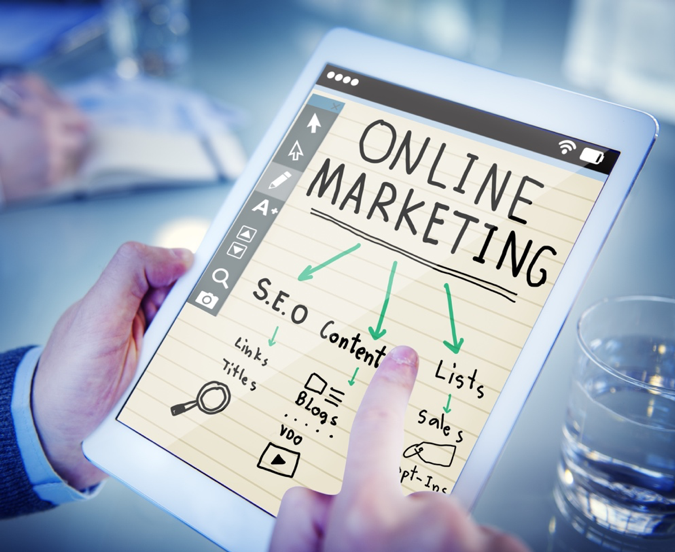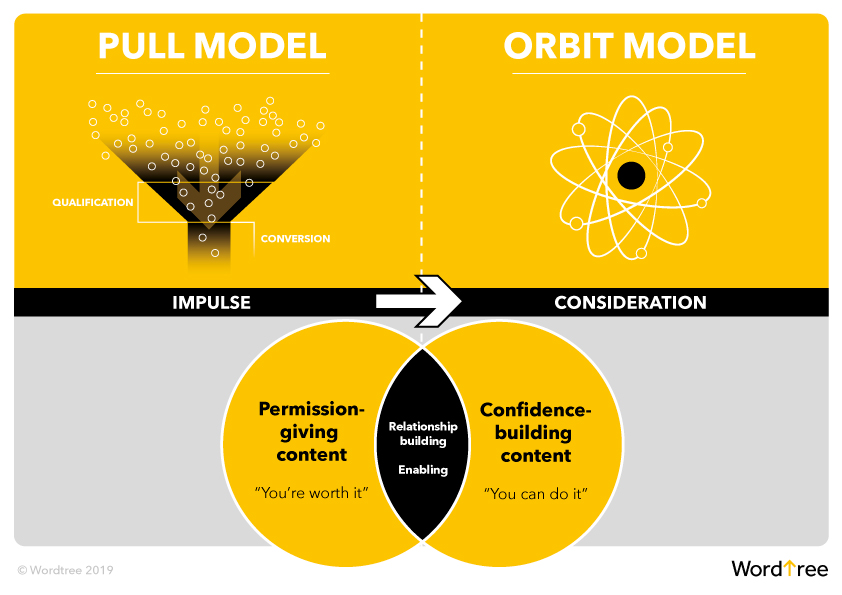
The promise of content marketing is beguiling. In it, you provide content – video, text, images, games, quizzes – that resonate with people who could easily be interested in buying products like yours. They find your content and then a proportion of them buy directly from you.
As a model, it seems to have everything. It feels manageable: You sign up to a platform like Hubspot, and you create content containing search terms that align with your product. Then all you have to do is sit back and watch your prospects rush into your sales funnel. There’s no more wasting time and money getting in front of people who may never have been interested in your product in the first place. Instead, you’re only dealing with people who are searching for your sort of thing anyway.
It also feels affordable – especially compared to big-budget items like TV ads or multi-channel campaigns.
Even better, it promises robust statistics – where you can prove return on investment for each piece of content you create.
The rewards from content marketing seem promising
It’s like reverse fishing. Your prospects are casting lines out all over the place – and by the power of Google, you’re catching their hooks and pulling them into your world. Which is why this type of marketing is often called “pull” marketing or inbound marketing. You’re not going out to your audiences – you’re bringing them in to you.
What’s not to like?
Well here’s the thing. The pull model of content marketing only works in certain circumstances.

If you’re selling goods that can be bought on impulse, the pull model could work very well for you.
Let’s imagine you’re selling £10 bottles of sparkly nail polish.
You know that people likely to buy your nail polish are currently searching terms including: beach looks, sparkly nail tutorial, how to apply glitter nail varnish and festival nails. So you create worlds of content that address each of these search needs and terms.

You launch a whole series of Instagram pics around beach looks. You start conversations on Facebook about beach looks and invite users to share inspiration and their own ideas. You create “how to” videos for YouTube and post them on Pinterest and FB. You get likes and shares. Google notices. Quickly, you start coming out on top whenever someone searches “beach looks”.
Once a potential customer has interacted with you, they’re more likely to buy from you than if they hadn’t. In fact, the journey from a nice image on Pinterest through to an online purchase can take just seconds. You use a platform to track your customer’s journey to purchase too, which means as well as great sales, you can identify specifically which images, tutorials or blog posts lead to the best rates of conversion – and do more of them.
This pull model, however, only works reliably under these circumstances:
- Your product or service is an easy impulse purchase
- It has a relatively low price point
- Buying it involves a simple decision
- It’s self-justifiable – only your customer is involved in the purchase decision
- There is a really short buying cycle
- The purchase gives the buyer instant gratification and an endorphin boost
The fundamental premise of all Pull Model content is permission. Treat yourself. Go on. You’re worth it. You’ll regret not doing it. You’ll actually be saving yourself money. You’ll look great. It’s easy. You’re allowed.
That’s why pull content works perfectly for nail polish. Or an album on iTunes. Or a plastic wendy house. Or anything you could buy in a supermarket. It’s about being there with the right ideas in circumstances where it takes very little decision-making effort to part with a relatively small amount of cash.
The formula for creating content for these impulse circumstances is: Give it a click-baitey title, make it short, make it easily digestible.
What works for nail polish won’t work for B2B
The problem comes when you try to use this model for more complex purchases. Like buying expensive software, consultancy or professional services.
The Pull Model is often spruced up for this purpose, with an extra layer added – often requiring “leads” to exchange contact details for the ability to download information.
One of the curious things about the Pull Model in a B2B context is that suddenly, anyone visiting your website is seen as a lead – a potential client. And anyone actually downloading your content is a “qualified lead” – someone who’s ready to convert to making a purchase. And by “ready”, the Pull Model means within a few weeks, tops.
The Pull Model says that the B2B content marketing journey goes: White paper/webinar/post, follow-up email, follow-up email, conversation, sale.
If this were true – and in our experience, it really isn’t – an interesting article about intellectual property law and bioethics would result in at least a couple of new clients for a law firm in as many months.
If you buy into this premise as a marketing team, then you might fully expect a quick return on content that costs a few hundred or couple of thousand, to the tune of 1,000%+.
But of course, it doesn’t work out this way.
The marketing team behind the bioethics whitepaper check their content marketing platform daily. What the heck is going on? Only a handful of people have even looked at it. Even fewer have downloaded the full version. And three months after it was first published, it hasn’t converted a single new client.
What’s gone wrong?
B2B purchases are considered, not impulsive
The simple fact is that the Pull Model doesn’t work when decision-making around a purchase is more complex. That is, unless you are extraordinarily lucky and all the stars align to match your white paper with someone who’s currently searching for an IP lawyer with a particular point of view on bioethics – and who has budget and buy-in to commission your services right now – your content will not be a trigger for conversion.
However, what it can do is become part of your potential client’s world, giving her a steady stream of information she will need as she makes complex decisions and goes through lengthy processes involved in corporate buying.
We call this the Orbit Model. In it, you become a regular part of your potential client’s universe. You provide information, tips, inspiration and thought leadership that help them to do their job and navigate the world of work.
If you are an IP lawyer, a consultant or a provider of plant machinery, your products and services are never going to be bought on impulse. Instead, they are considered purchases, and they are characterised by:
- Higher price points
- The decisions leading to purchase being complex
- Needing the buy-in of a wider group before the purchase can be made
- A long buying cycle – it could take months or years for the person who’s downloaded your whitepaper to be in a position to buy your services
- The purchase is somewhat stressful – because if your potential client gets it wrong, their job or reputation could be on the line
All of this means there isn’t a straightforward funnel from your content to conversion.
You need to build relationships
What there is, however, is an opportunity to become a constant fixture in your potential client’s world – helping her with insights, how-tos and any other information she needs. In it, your insightful and entertaining information orbits around her regularly and reliably.
Then, when the stars do align, when there is appetite for your services and budget available, yours is the name she’ll know and trust. You will almost certainly be one of the people she calls. And if her procurement processes allow, you may be the only person she calls.
So can content marketing transform your B2B brand? It depends what you mean by “transform”. It’s very unlikely to give you instant sales, whatever the purveyors of content marketing platforms tell you.
The reasons are multiple.
First, how many people do you think might be browsing online right now who could be half-tempted to buy a low-value bottle of nail polish? The number is going to be at least hundreds – and it could be hundreds of thousands. On the other hand, how many people are hunting online for insight into the bioethical implications of intellectual property law at any given time? Single digits. Or none.
Where lots of people are in a state of mind that could be enticed to “click to buy”, you have a funnel of sorts – an opportunity to set up an enticing shop entrance. When very small numbers of people with highly specialised and highly complex needs are hovering close to your content, you don’t. It’s not a shop entrance – instead, it’s the equivalent of an opportunity to chat at a conference.
Second is also to do with numbers. Do you know what it takes for a search term to become a thing? It takes lots of people searching for it. If you ever wanted to use pay per click (PPC) sponsored content or ads as part of your online marketing approach, this becomes important. Because lots of people are searching (probably) for beach looks right now, Google will allow your company to bid to have your content appear when a potential customer enters that search term. On the other hand, IP law and bioethics probably isn’t searched for in high enough numbers for it to be worth Google’s effort to allow you to bid on that search term. So you have to rely on straightforward, unsponsored, organic search instead. In itself, this isn’t the end of the world, but it’s a consideration – because you will need to take the time to build up a volume of content rather than pay to come top.
So if content marketing doesn’t convert immediately, is there any point investing in it?
If you need to get instant traction and are considering pinning all of your marketing efforts on it, then no. It won’t work for you.
It especially won’t work for you if you create content in the formulae dictated by the Pull Model. Click-batey headlines, 10 reasons you should do XXX and super-short, funny or cutesy approaches used in Consideration purchases feel deeply inappropriate:
This woman discovered bioethics! See what happened next…
Or
5 things you never knew about bioethics and intellectual property!
But if you accept the Orbit Model and know that the return on investment in your content will be slower and less direct, then yes, it’s worth going for.
The question to ask yourself is: What will happen if we don’t publish regular, interesting content? If you’re doing fine without it, then maybe leave the whole content marketing thing alone. But you need to think whether your competitors getting a head start on relationship building because they do it and you don’t.
If you decide to go for it, you need to know that your audiences are not looking for permission. Instead, they’re looking for reassurance. They’re probably also looking for ways to build their confidence with skills and insight. So the fundamental message in all your content is: You can do this.
And you need to publish information that’s relevant to them. But that’s probably the subject for another post…
You might also enjoy: Is B2B branding and marketing different from B2C?
Want to find out more about content marketing? Read our FAQs.
